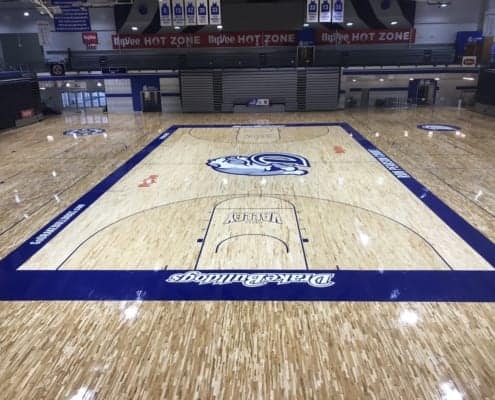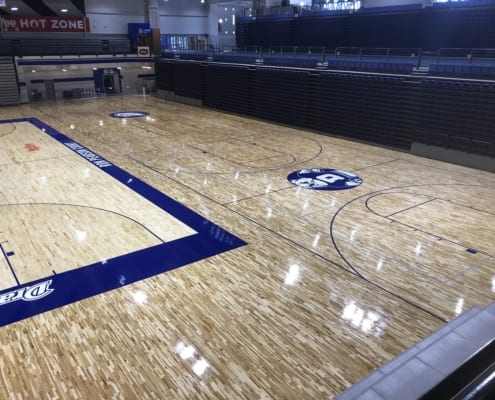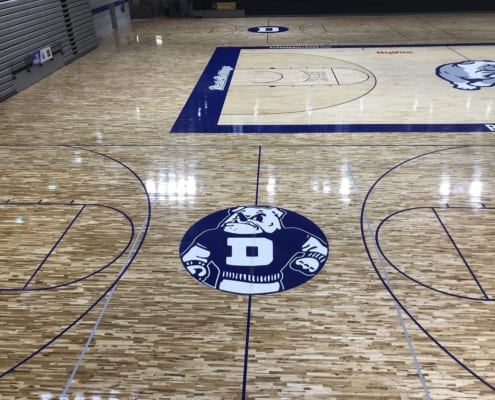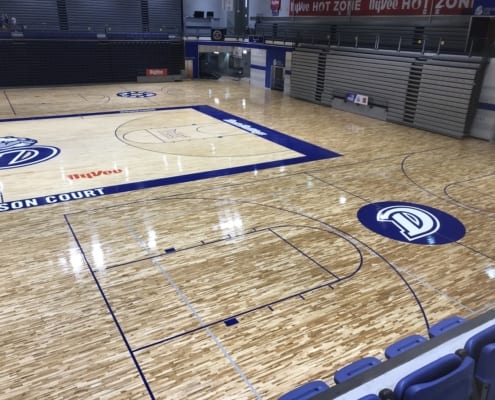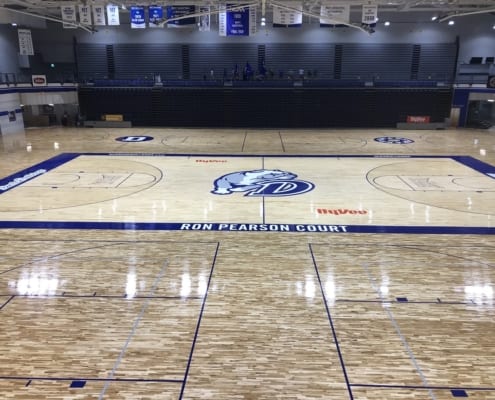Drake University
Knapp Center
“Anderson Ladd and Robbins was really helpful. We have all different kinds of events. It’s not just basketball games or volleyball games. We also have a lecture series, we have 17 graduation ceremonies, we have the ability to do six volleyball courts, so they worked with us on ensuring that we have flexibility to do all of those types of events.”
Project Overview:
When Drake University needed to replace an old, failing gym floor for the Bulldogs, cost, functionality and quality were just a few of the many considerations when choosing a new system for the Knapp Center. While a lot of decisions needed to be made, one thing was certain: Drake would rely on Anderson Ladd and Robbins Flooring to ensure the perfect floor would be installed. After all, Anderson Ladd installed a top-of-the-line Robbins MVP® flooring system at the university’s Shivers Practice Facility in 2014, as well as a dance floor on campus. Both projects were exceptionally well done, so turning to Anderson Ladd and Robbins again was the obvious choice.
The result was exactly what the university wanted: 30,000 square feet of a Robbins Bio-Channel SB® system, which met and exceeded the needs of the school and became the centerpiece of the Knapp Center. Drake distinguished the main competition court by using second and better grade maple for a cleaner look, and third grade was used around the perimeter of the main court for more character and variation in the color of the maple for an eye-catching design. The four secondary basketball courts and main court feature painted logos from different eras in Drake basketball history, making the entirely new surface a slam dunk.
Assistant Athletic Director – Operations/Facilities Brady Randall said the throwback was his secret project. He tediously sought out four meaningful Drake logos of years past as a nod to the rich history of the university and worked with Anderson Ladd to implement his idea.
“It turned out really cool. Really, really cool,” Randall beamed. “The first one is from our 1969 Final Four basketball team. The second one is from playing in our fieldhouse across the street. The third one is from the original Knapp Center when it opened in 1992 and then the fourth one is the most current logo, so just kind of a timeline through the history of Drake basketball.”
Randall said fans love it and he has a lot of people coming back to get photos with the logos including the 1969 Final Four team, who recreated an old photo of themselves with their logo.
Randall said the preceding floor was really a mishmash of several floors due to parts of the floor being replaced at different times. The pieced together playing surface lacked in performance and aesthetics.
“Part of the reason why we replaced it was they had [previously] replaced the center portion of our floor, so we had three different floating floors on our courts,” Randall explained. “It just wasn’t functioning very well. The side courts were original to the building from ‘92 so they were 26 years old when they were replaced. It just wasn’t performing the way it should because they were three different systems trying to work together and it just didn’t work.”
And while the center court was only about a decade old, Randall said it needed to be replaced, as well. The outdated permacushion system offered little resiliency and support and compromised athlete safety and performance.
“Permacushion is a really generic system,” said Anderson Ladd Facility Solutions Specialist Noah Johnson. “There’s nothing proprietary about it. It’s just a pad on the bottom side of two layers of plywood really.”
In Drake University’s case, the floor was becoming damaged in part due to the paneled permacushion, which couldn’t support the heavy equipment the university needed to use on the floor.
“I would call it an antiquated loading floor system that was getting severely damaged from the heavy rolling loads of those bleachers,” Johnson said. “It was smushing the system but the Bio-Channel SB solved that issue for them.”
The built in self-blocking feature and continuous interwoven subfloor design allows the system to “bottom out” on itself to support heavy loads. When heavy equipment is placed upon a sports floor, the floor can only deflect or bend so much before damage occurs. Self-blocking is built into the floor at the factory level to ensure proper subfloor construction that lowers the risk of damage from heavy equipment.
This project, completed in 2018 was also chosen as a finalist in the Robbins Sports Surface of the Year contest that year.
Proven Safety:
Drake University’s commitment to student-athlete safety is unwavering. Because the well-being of their athletes is of utmost importance, they needed a safe playing surface. A lesser quality floor results in more athlete injuries and less playing time, but affects an athlete’s future career in sports and the overall program at the school. Drake’s previous floor was fracturing due to the failing permacushion support underneath. According to Johnson, one athlete was injured and actually impaled by a splintered piece of wood due to the breakdown of the system.
“Even the floor cleaning machine on the floor was pulling up chunks of the old system which wasn’t ideal,” Randall detailed. “We were patching it and filling it with wood putty and aesthetically it wasn’t pleasing and certainly function-wise it was not doing well either.”
The Bio-Channel SB exceeds all third party industry standards for optimal safety and performance. With its Zero/G® Shockpad, it’s the ultimate in vibration control to safeguard the well-being and performance of the athlete.
Johnson said because the SB is an anchored system versus a floating system, it’s anchored into concrete minimizing vibration.
“By reducing vibration it’s going to be healthier for athletes because their bodies don’t vibrate along with it and the more the body vibrates, the more it gets fatigued and the more opportunity you have for injuries,” Johnson said.
Proven Performance:
Due to budgetary constraints, the MVP wasn’t an option for this floor, so the university opted for the next best thing, the Bio-Channel SB. Randall said he knew the project would go smoothly working with Anderson Ladd because of their long-standing great relationship.
“They were really helpful,” Randall said. “We went through some different ideas on how to do the floor with the retractable bleachers and our needs to have the flexibility to change things around. We have all different kinds of events. It’s not just basketball games or volleyball games. We also have a lecture series, we have 17 graduation ceremonies, we have the ability to do six volleyball courts, so they worked with us on ensuring that we have flexibility to do all of those types of events.”
Randall said he couldn’t be happier with the entire process and recommends Robbins, Anderson Ladd and Noah Johnson every chance he gets.
“We have high hopes of this floor lasting a long time and we’ll continue to work with them and make sure this floor does last a long time.
Proven Winners:
“It’s just a huge upgrade for the facility and the athletes are going to perform much better in particular with the challenges they had,” Johnson said.
Last season the men’s basketball team was expected to finish toward the bottom of the Missouri Valley Conference, but practicing on a Robbins MVP and now playing on their new Robbins Bio-Channel SB floor helped the men’s team make it to the semi-finals, and the women’s team make it to the finals in the 2019 Missouri Valley Conference tournament.
“I think the community sees the investment we’re making into the basketball program,” Randall said. “We installed a new floor. We also invested in some new lights in the arena so we have devoted some resources and put some attention into the basketball programs. None of that hurts the fan base or hurts the success of our programs. It helps us certainly in the aesthetics of our program and we’re showing off our new floor and talking about the quality of our floors to our recruits. That’s ultimately playing a role in the success.”

